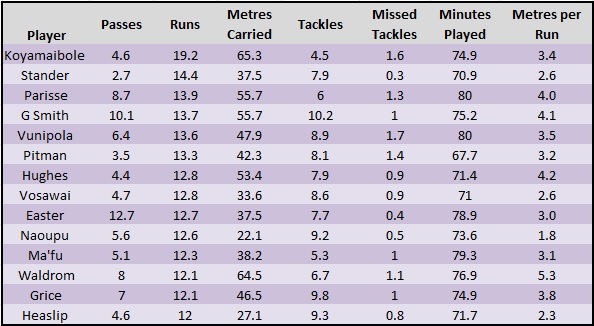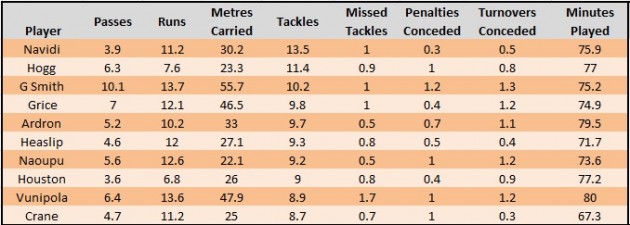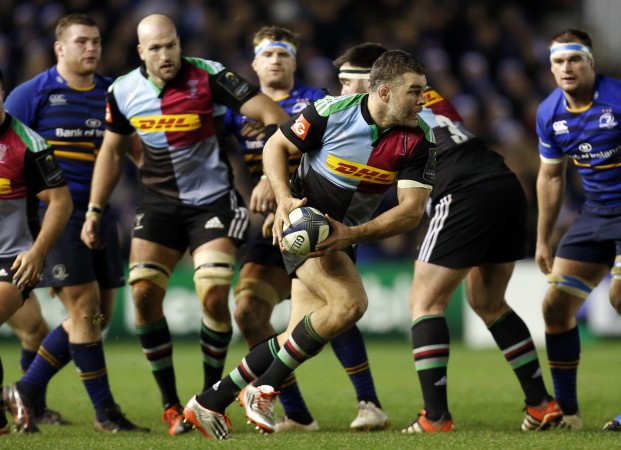In 2013, then Scotland head coach Scott Johnson received a few laughs for his “statistics are a bit like bikinis – it shows a lot but not the whole thing” line. He did have point though and individual rugby statistics can be used out of context to ‘prove’ anything. Weighted toward quantity rather than effectiveness, it is easy to fall into the trap of saying Player A is the best, simply because they have made the most runs or tackles.
That doesn’t mean the match stats should be rejected though. They can still reveal trends that might go unnoticed during a match. Here is a look at how No 8s from the Aviva Premiership, Guinness Pro12 and Top 14 have performed this season in both domestic and European competition. Opta stats have been used to give an understanding of what an average match performance for a starter might consist of. To make it fairer, only players that have made at least eight starts were considered. That left a collection of 42 players, with a split of 16 from the Top 14, 11 from the Premiership and 15 from the Pro12.
If comparing the leagues on a very basic level, the France-based No 8s carry more but tackle less. While it does seem that the Premiership representatives are far more active in the lineout, the inclusion of Josh Beaumont and his average of 5.8 takes a game is a factor in that.
In most cases the No 8 is going to be a key ball carrier in the team and one way of measuring how effective they are in that regard is by looking at how many metres they average with each run. There is the caveat that it doesn’t differentiate between gains from kick returns compared to the ‘hard yards’ into heavy traffic.
There are nine players that have made at an average of 4.0 metres per carry or greater, with Exeter Chiefs’ Thomas Waldrom topping the chart with 5.3 metres. The ‘tank engine’ has scored nine tries in 13 Premiership games so far and been revitalised – or perhaps refuelled – since his move to the Chiefs. The high number of defenders beaten and offloads for Nathan Hughes and Louis Picamoles matches the accepted view of how both players usually perform.
An interesting point is whether carrying can come at the expense of others areas in the game. Below is a look at players who average 12 or more runs a match.
Brive’s Fijian bulldozer Siya Koyamaibole makes an incredible 19.2 carries every starting appearance. He does make less passes and tackles than his peers though, starts less matches and is ranked second highest for both penalties conceded and missed tackles.
Knowing that the 19st behemoth rapidly approaching is unlikely to pass may not be much comfort for a tackler at the time, but over a long period a lack of distribution may hinder an attacking side. CJ Stander is the only other player that makes over 14.0 runs a match and it is noticeable that his 2.7 passes a start is one of the lowest figures for these 42 players.
There were some complaints from fans when Josh Navidi didn’t make the recent Wales squad. Below it can be seen that he is the top tackler at No 8 this season with an average of 13.5 a start.
The volume/quality proviso shouldn’t be forgotten for the tackle stats, but 13.5 does stand out considering the average for all the players in this data set is 7.5. The Cardiff Blues back-rower also has a low error count and given he has played frequently at flanker, his presence at the top of this list may not be a surprise. While an average gain of 2.7metres per run is low compared to rivals, his strong carrying performances against Treviso and particularly Leinster in the Pro12 would alleviate any concerns of him being only a defensive option at No 8.
So to try and identify those players that may possess an ‘all-round game’, here is a look at combined passes, runs and tackles – termed ‘action’ in this instance. Due to the great number of carries, Koyamaibole still makes the list – despite a below average rate for tackles and passes. The experienced George Smith is the only player to average over ten passes, runs and tackles per start and indeed, eight of the 12 players that manage over 25 ‘actions’ an appearance, are over the age of 30.
It has been suggested that a reason for Nick Easter’s non selection in England squads from 2012-2014 was due to Stuart Lancaster’s worry that the Harlequins No 8 wouldn’t be able to play at the requisite level of intensity in the upcoming Rugby World Cup. However since 2011, Easter has racked up 1723, 2181, 2446 and 1419 minutes of game-time in the respective seasons, so hasn’t yet shown signs of fading.
Easter ranks top for passes, fourth for offloads and despite a large number of involvements a game and generally remaining on the pitch for the full 80 minutes, his rate of turnovers conceded (0.6) and missed tackles (0.4) is also low. While it can be said again that these stats don’t say anything about effectiveness, he does manage to avoid any significant drop offs in other areas, unlike many of his rivals across Europe.
England do enter the Six Nations with injury concerns, but the No 8 cupboard looks well stocked. Just don’t ask to see them in a bikini.










